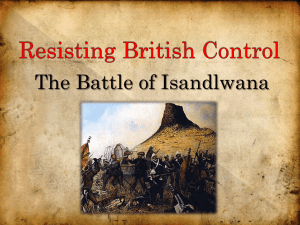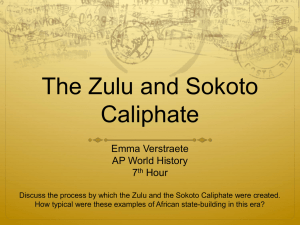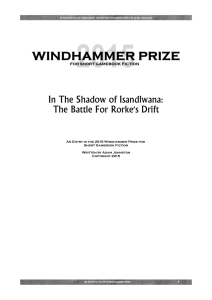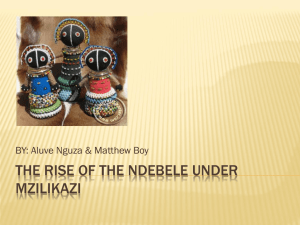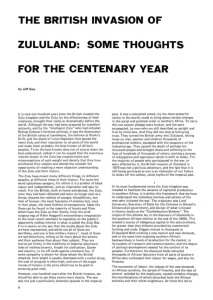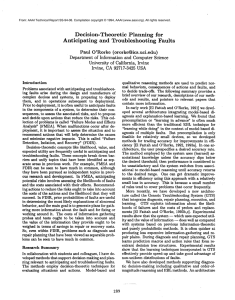The Zulu Wars C aim – to analyse why the British
advertisement
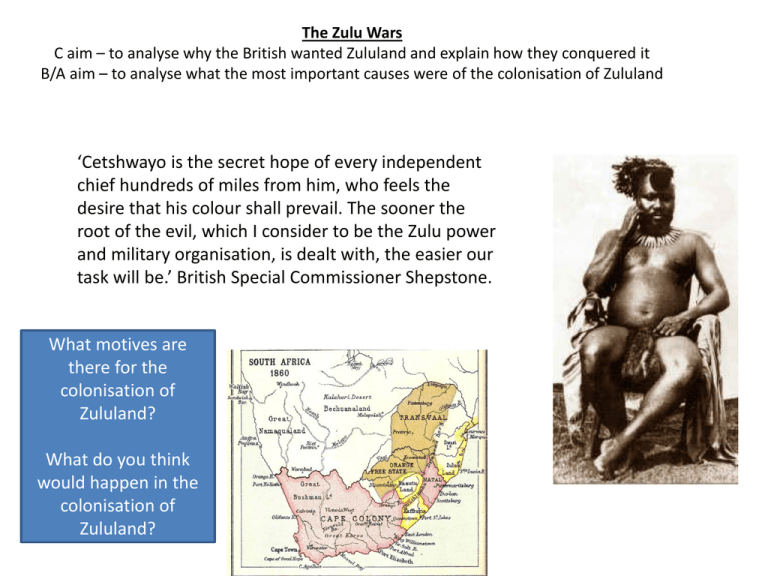
The Zulu Wars C aim – to analyse why the British wanted Zululand and explain how they conquered it B/A aim – to analyse what the most important causes were of the colonisation of Zululand ‘Cetshwayo is the secret hope of every independent chief hundreds of miles from him, who feels the desire that his colour shall prevail. The sooner the root of the evil, which I consider to be the Zulu power and military organisation, is dealt with, the easier our task will be.’ British Special Commissioner Shepstone. What motives are there for the colonisation of Zululand? What do you think would happen in the colonisation of Zululand? The Background • Policy of Confederation – early 1870s Britain hoped to unite its southern African colonies (the Cape and Natal), with the Boers states of the Orange Free State and the Transvaal, into one country, under British supremacy. In 1877 the British formally annexed the Transvaal. Orange Free State was not annexed. Why did war with the Zulus look likely? Shepstone had established agreements with the powerful Zulu warrior kingdom. However, new colonialists were trying to establish their position and taunted him for this. Frere decided he would have a new approach. The British wanted to expand their policy of confederation to the Zulu kingdom for the possibility of more minerals, to access a new black African labour force, and to protect routes to the mines. Shepstone had reached an agreement with Cetshwayo’s father that the Zulus must give a strip of land in the North of Natal to the Boers as they had ancestral rights there. However, now that Cetshwayo had established power as a result of Civil War, he wanted to gain further support. He informed Britain that this agreement was no longer valid and that the Zulus would be maintaining their rule over this strip of land. How did these men influence the colonisation of Zululand? Shepstone Frere Rorke’s Drift In December 1878 the Zulus were awarded an area of Natal by the British as the Boer’s could not produce any documentary proof that the former king had given it to them. However, the new British governor and high commissioner of the cape Frere gave them this news with an ultimatum valid for 30 days, that the Zulus must allow missionaries to be restored (although they had never actually been expelled!), the King must abolish his military system and that the King must accept a British Resident (that Zulu land became a protectorate). This was issued due to the Policy of Confederation, long running feud with the Zulus, Frere trying to establish himself in his new position, and Frere whipping up a press campaign to gain support. The Zulus refused as it would effectively have meant that Cetshwayo would have had to revoke his kingship. and 30 days later the British invaded in January 1879. The British set up camp at Rorke’s Drift and sent scouts and marched some men to go and defeat the Zulus. The Zulus left Ulandi (their royal capital), they defeated the British at Isandhlwana. They then went around the British, and awaited in a ravine near Rorke’s Drift so that they could not be seen. Rorke’s Drift Look at the picture and answer these questions. 1. What is happening to the British and Zulus at Rorke’s Drift? 2. Queen Victoria commissioned this painting, why would she have done this? 3. How may the painting be inaccurate? Only a handful of British men survived. Example Example Reason Score Example Example Why did the British want to conquer Zululand? Reason Example Score Example Example Reason Example Example Score Homework – Due Thursday 21st November • Research the Zulu wars online and produce a handwritten timeline showing the sequence of events

